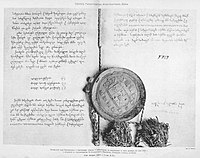Georgievsk Treaty
In the Treaty of Georgievsk ( Russian Георгиевский трактат, Georgian გეორგიევსკის ტრაქტატი) Eastern Georgia ( Kartlien- Kakhetien) placed itself on July 24, 1783 under the suzerainty and protection of the Russian Empire . The treaty was negotiated at the Georgievsk fortress in the northern Caucasus and signed by Prince Pawel Sergejewitsch Potjomkin as well as Garsewan Chavchavadze and Ioane Muchranbatoni and ratified in early 1784 by the Georgian King Erekle II and Catherine II of Russia.
prehistory
The treaty was initiated by the Georgian King Erekle II. After the Russo-Ottoman war, he reckoned with an invasion of Georgia by the Ottoman Empire , possibly also by the Persian Empire . Erekle tried to set up a powerful Georgian army, but the money was lacking. Requests for help from the states of Western Europe failed. Therefore he proposed a protection treaty to Russia. A major reason for accepting this proposal was the same Orthodox Christian religion as Georgians and Russians.
content
In the treaty, the Georgian king undertook to recognize the Russian protectorate and to put his armed forces in the service of the Russian Empire. Russia guaranteed the territorial integrity of the Georgian kingdom and promised military and political assistance against external threats. The treaty also guaranteed the royal status of the Georgian Bagratid dynasty . Georgia's internal administration , jurisdiction , laws and tax collection should remain untouched. The Russian military and civil administration should not interfere in Georgia's internal affairs.
In the secret articles of the treaty, Russia promised to urge the Ottoman Empire to return Kartlien - Kakheti . Russia was to station two battalions and four cannons in Georgia, and the Russian commander for the Caucasian border was responsible for providing additional troops in the event of an invasion.
Georgians were allowed to settle freely in Russia and cross the border unhindered. Merchants were also free to trade across the border.
Consequences and Effects
In terms of foreign policy, the treaty was disadvantageous for Georgia because Russia was unable to meet its obligations. Both the Ottoman Empire, but especially Persia, viewed the treaty as Russian aggression. The two battalions were insufficient to protect Georgia. Even this symbolic presence was withdrawn in 1787, leaving Georgia exposed to the retribution of its two Muslim neighbors alone. Shah Aga Mohammed Khan asked Erekle II to terminate the Georgievsk Treaty and to recognize the supremacy of Persia over Georgia again, which Erekle refused. Erecle's troops were able to repel the Turks. When the Persian Shah Aga Mohammed Khan invaded Georgia in 1795 , Russia did not grant Georgia any protection. In the Battle of Krtsanisi the Georgians were defeated by the Persians, Tbilisi was occupied, looted and destroyed, with the Persian troops causing a massacre. Russia declared war on Persia in 1796, and a Russian invasion of Persia that Valerian Alexandrovich Subov was to lead was canceled in 1796 by Katharina's heir to the throne, Emperor Paul .
After the death of King Erekle II in 1798 and his successor Georgi XII. in 1800 Russia broke the Georgievsk Treaty and abolished Georgia's monarchy. The members of the Bagratidendynastie were arrested and in 1803 into exile spent. The autocephaly of the Georgian Orthodox Church has been abolished.
Celebrating the 200th anniversary
In 1983, the 200th anniversary of the conclusion of the treaty was celebrated in the Soviet Union. To mark the occasion, several monuments were erected along the Georgian Army Road, such as the monument to the Russian-Georgian friendship. Georgian dissidents, however, recalled that Russia had broken essential parts of the Georgievsk Treaty and called for a boycott of the celebrations; several Georgian activists were arrested.
literature
- Traité conclu en 1783 3ntr Cathérine II. Impératrice de Russie et Iracly II. Roi de Géorgie . Recueil des lois russes, vol. XXI, No. 15835, Avec une péface de M. Paul Moriaud, Professeur de da Faculté de Droit de l'université de Genève, et commentaires de A. Okouméli, Genève 1909
- David M. Lang: The last years of the Georgian Monarchy: 1658-1832 . Columbia University Press, New York 1957
- Nikolas K. Gvosdev: Imperial policies and perspectives towards Georgia: 1760-1819 . Macmillan [u. a.], Basingstoke [et al. a.] 2000, ISBN 0-312-22990-9
- Zurab Avalov: Prisoedinenie Gruzii k Rossii . Montvid, S.-Peterburg 1906
Web links
- Georgievsk Treaty in full (English translation of the Russian text)
- Georgievsk Treaty and List of Georgian Noble Houses Recognized by Russia
Individual evidence
- ↑ a b c Alexander Mikaberidze: Historical Dictionary of Georgia . Scarecrow Press, Plymouth 2007, ISBN 978-0-8108-5580-9 , pp. 326 .
- ↑ a b c Alexander Mikaberidze: Historical Dictionary of Georgia . Scarecrow Press, Plymouth 2007, ISBN 978-0-8108-5580-9 , pp. 327 .
- ↑ Alexander Mikaberidze: Historical Dictionary of Georgia . Scarecrow Press, Plymouth 2007, ISBN 978-0-8108-5580-9 , pp. 412 .
- ↑ Firuz Kazemzadeh: Iranian relations with Russia and the Soviet Union, to 1921 . In: Peter Avery, Gavin Hambly and Charles Melville (Eds.): The Cambridge History of Iran . tape 7 . Cambridge University Press, 1991, ISBN 978-0-521-20095-0 , pp. 329 .
- ^ David M. Lang: The last years of the Georgian Monarchy: 1658-1832 . Columbia University Press, New York 1957, pp. 247, pp. 255
- ↑ Lyudmila Alexejewa: История Инакомыслия в СССР, Грузинское национальное движение . 1983 ( memo.ru ).


